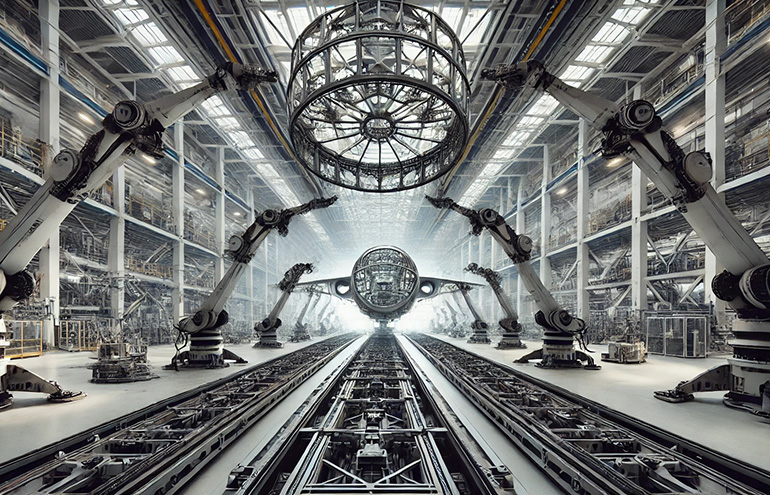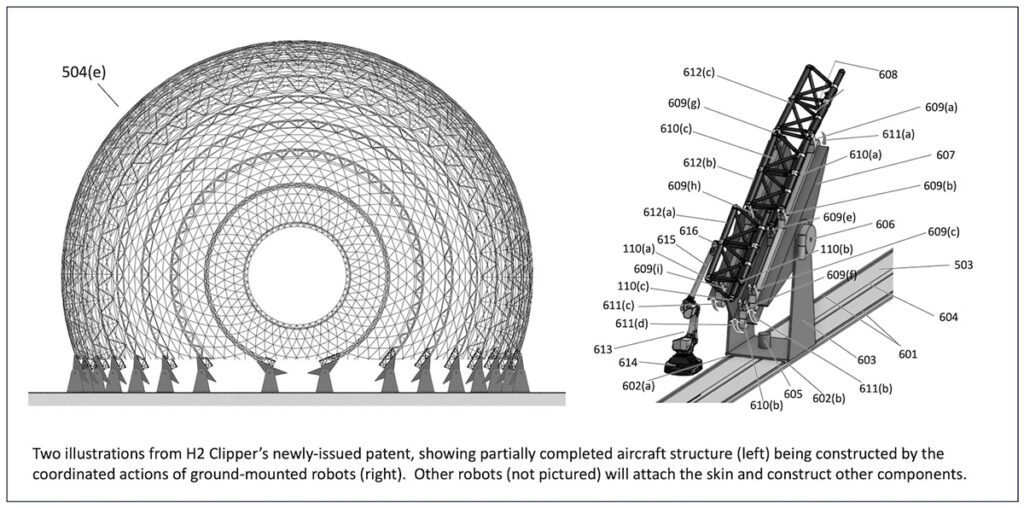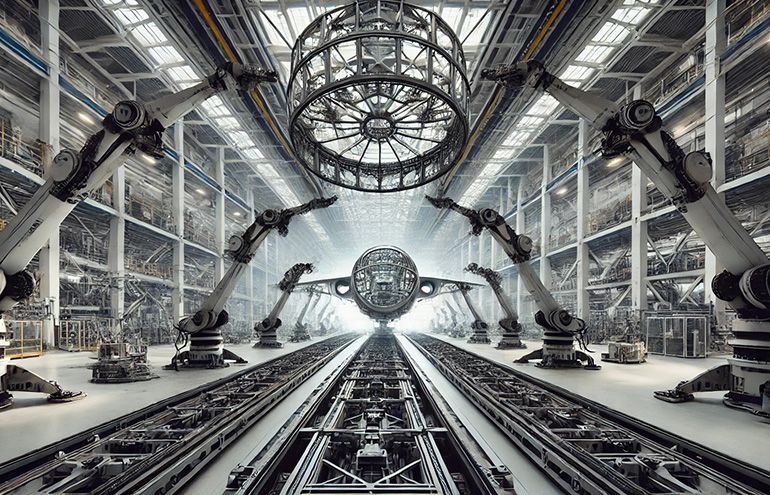
Swarm robotics could transform aircraft manufacturing, as seen in this AI-generated image of a futuristic factory. Source: World Business Academy
Aircraft manufacturing is on the cusp of its most profound transformation since the dawn of powered flight. The assembly line, a staple of industrial production for over a century, is about to be replaced by a far more efficient and cost-effective alternative — swarm robotics.
Swarm robotics is a manufacturing system in which autonomous robots work with a common “consciousness” guided by generative artificial intelligence, or “genAI,” to self-program a large-scale manufacturing process.
The assembly-line system, invented by Ransom Olds in 1901 and refined by Henry Ford in 1913 to make his cars, has dominated manufacturing. However, swarm robotics could transform the way large, complex structures such as airplanes and aerospace assets are built. The use of AI-driven, self-coordinating robots could enable faster, lower-cost production while delivering higher precision and enhanced safety.
Climbing the ladder of robotics and AI to swarm robotics
Programming robots using conventional coding, no matter how sophisticated, is not artificial intelligence. It is simply computer programming of automated machines. While useful, it is merely the first rung of the AI ladder, which we’ll refer to as “Level 1” robotic programming.
The next rung up is “true” AI, or what we’ll label “Level 2” robotic programming that enables machines to process data, make predictions, and assist in decision-making. When the programming is used to animate a machine, it uses a system developed to provide the machine with the ability to learn, understand, and solve problems for a particular activity or application.
This form of automation is widely used today in quality control, logistics, and predictive maintenance, but it remains reactive. High-speed computer processing and data analytics can perform repetitive tasks, provide predictions, and iterate insights into complex questions that humans could not do without assistance.
By contrast, genAI, or “Level 3” robotic programming, enables robots to train themselves based on vast amounts of data, recognizing patterns, optimizing processes, and autonomously improving their performance–without direct human programming. This shift from human-defined algorithms to self-evolving AI could ultimately make swarm robotics capable of unprecedented levels of precision, adaptability, and efficiency.
Most people are familiar with ChatGPT, which uses genAI models that extract vast amounts of data from the internet to generate high-quality, human-like text, images, and other content in response to a user’s request. Swarm robotics will apply the same principle to manufacturing, allowing industrial automation to coordinate action, communicate, and adapt their processes in real-time.
“Swarm robotics,” as the term is used in U.S. Patent 12,234,035, will use genAI to create a self-learning common mind among two or more interconnected autonomous mobile robots (AMRs) and industrial robot arms that interact with each other and react to the environment. These robot swarms will be used to manufacture large physical structures like airplanes and spacecraft without moving the structure during production and with minimal human operators to supervise their activities.
This eliminates the assembly line entirely.
The speed and accuracy obtained from using swarm robots operating 24 hours per day would save massive amounts of cost and time. In a similar vein, swarm robotics could permit a level of accuracy in the fabrication of existing aircraft designs by eliminating human error caused by fatigue, distraction in the assembly process, or failure to adhere strictly to fabrication designs. They could also eliminate errors caused by carelessness, such as omitting to properly bolt an aircraft door.
The advent of swarm robotics represents an even greater transformation in manufacturing technology than England and then the world experienced from the substitution of machines for human labor during the first Industrial Revolution.

A diagram of a swarm robot assembly for a dirigible from a recent patent. (Click here to enlarge.) Source: World Business Academy
Aircraft manufacturing continues a century of change
The earliest aircraft, including the Wright Flyer (1903), were hand-built by skilled craftsmen in small workshops. With World War I, the demand for military aircraft skyrocketed. To meet production needs, experimenting with assembly-line techniques began in the U.S., the U.K., France, and Germany.
Once Henry Ford’s Highland Park factory (1913) perfected the moving automotive assembly line, other industries took note of this breakthrough technique. Early in this period, the aircraft industry began to see how it could dramatically increase aircraft production while reducing the manufacturing cost by using assembly lines.
The Curtiss JN-4 “Jenny”—one of the most-produced aircraft of WWI—was built using early assembly-line principles, although work was still highly manual.
Well before it would become urgently needed in the run-up to World War II, assembly lines began producing aircraft in ever-increasing numbers globally. Ford’s Stout Metal Airplane Division (1925) was one of the first to adopt a moving aircraft assembly line to build the Ford Trimotor, applying lessons from automotive production.
The Douglas Aircraft Co. (founded 1921) and Boeing (founded 1916) refined modular sub-assembly production, breaking the aircraft into major sections including the fuselage, wings, and tail for simultaneous parallel construction before final integration.
Indeed, without the technology, it could be argued that World War II could have had a different ending. Ford’s Willow Run Plant (1941) was a breakthrough—capable of producing one B-24 bomber per hour, thanks to a moving assembly line inspired by auto manufacturing.
During this same period, Boeing, Lockheed, and Douglas massively scaled up aircraft production using the assembly-line model, producing legendary aircraft such as the B-17 Flying Fortress, the P-51 Mustang, and the C-47 Skytrain.
In all, the U.S. aircraft industry produced over 300,000 aircraft during World War II, which would have been impossible without assembly lines. For this, we owe a great deal of gratitude—assembly lines enabled aviation manufacturing to scale in ways never before imagined.
However, while assembly lines revolutionized aircraft production in the mid-20th century, they were designed for an era when aircraft were simpler, smaller, and built in high volumes.
Aircraft manufacturing has evolved, but the assembly-line model has not. Modern aircraft are larger, more complex, and produced in lower volumes, making rigid, linear production methods increasingly inefficient.
Swarm robotics promises to overcome production limitations
The limitations of traditional assembly lines—massive factory footprints, costly infrastructure, and an inability to adapt to modern aerospace materials—have become roadblocks to progress. Assembly lines require massive factory spaces, demand huge capital investments, and struggle to integrate new materials and manufacturing techniques. These challenges only grow as aircraft structures become more advanced and supply chains more fragmented.
To meet the demands of 21st century aerospace, the industry needs a new technology that eliminates these inefficiencies—one that is adaptive, intelligent, and capable of assembling aircraft faster, cheaper, and with greater precision. That solution is swarm robotics. The aircraft manufacturers that utilize this new production technique first will have a dramatic competitive advantage over their slower-to-adopt peers.
This new era holds tremendous potential. Not only might swarm robotics transform manufacturing processes, but it could also affect the social and economic industry landscapes. In my next piece, we’ll examine the development of swarm robotics.
 About the author
About the author
Rinaldo S. Brutoco, founding president and CEO of the World Business Academy, is an entrepreneur, executive, author, radio host, and futurist. He has published numerous articles and books that address the role and responsibility of business in relation to the critical moral, environmental, and social concerns of the day.
Brutoco is a regular keynote speaker at conferences and a guest lecturer at business schools such as Stanford Business School, the Columbia Graduate School of Business, the Kellogg Graduate Business School at Northwestern University, and the Keenan-Flagler Graduate School of Business at North Carolina University. For over 35 years, he has been widely recognized as a practical visionary and change agent.
The post Swarm robotics could spell the end of the assembly line appeared first on The Robot Report.


 About the author
About the author